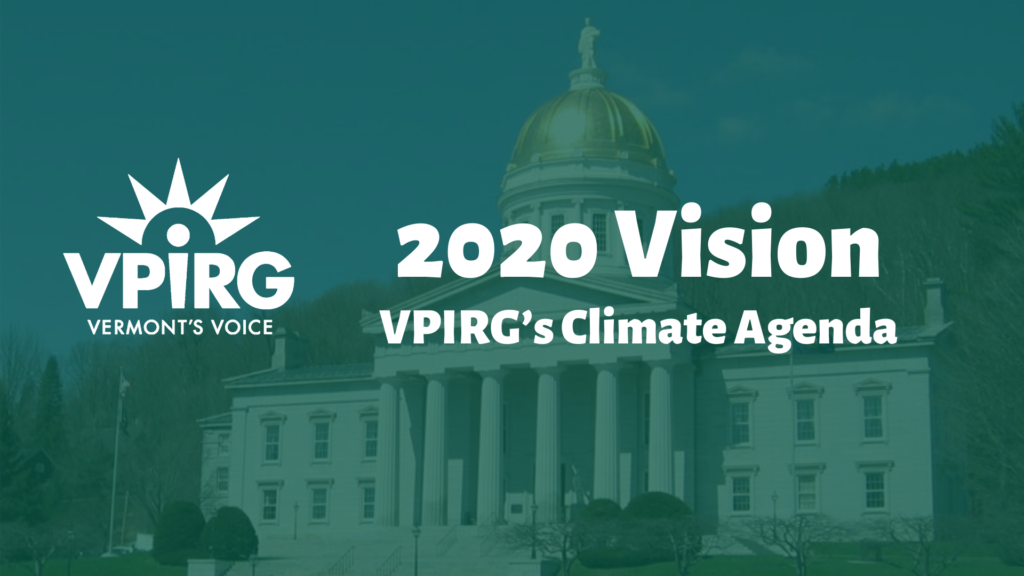Climate change is here now, and it is affecting the quality of life and pocketbooks of Vermonters. More severe storms, deadly heat waves and growing tick populations are just some of the impacts. Since 2006, Vermont has had statutory goals to cut carbon pollution and do our part to combat this global crisis. Unfortunately, we have missed those goals by miles and our greenhouse gas emissions continue to rise dramatically.
There is a dire need for Vermont – and the world – to reduce the pollution that is warming our planet and threatening a stable, habitable world for young people and future generations. Strong policies must be put in place now to right this course. Thankfully, several important ideas are being discussed ahead of Vermont’s 2020 legislative session. To move from ideas to implementation, however, strong public engagement and political support is required.
All Vermonters who care about reducing pollution, moving to a more independent, equitable energy system, and putting people to work in the clean energy economy must get involved.
The following four policies are at the top of VPIRG’s climate and clean energy agenda in 2020.
The “Global Warming Solution Act”
Vermont must move beyond rhetorical support for action on climate and make our long-standing climate action goals requirements – as many other Northeast states have done. A “Global Warming Solutions Act” would:
- Establish binding targets with required & authorized action by one or more state agencies to hit said targets;
- Authorize citizen suits to force action if the state failed to meet climate milestones; and
- Set Vermont on a path towards a 28% reduction in climate pollution by 2025 (the goal the U.S. committed to as part of the Paris Climate Accord) and towards a target of net zero carbon emissions by 2050 at the latest and at least a 75% reduction from 1990 levels by 2050.
Institute a 100% Renewable Electricity Standard
Building off of Vermont’s current Renewable Energy Standard, which sets a 75% by 2032 renewable electricity requirement, the state should move faster and in concert with other states implementing necessarily ambitious targets and establish a 100% renewable requirement by 2030. There is a conversation underway to pursue this more ambitious policy and move the deadline up. Specifically, we support:
- 100% renewable electricity required for all utilities by 2030;
- Significantly increasing the requirement for newly built renewables (especially those built here in Vermont) – far beyond the 10% by 2032 currently required, with a focus on community and grid resilience; and
- Expanding “Tier 3,” the current RES’ “energy transformation” tier. This requires utilities to help their customers reduce fossil fuel consumption and greenhouse gas pollution from heating and transportation. It is important to maintain and expand this requirement, as a powerful money-saving, carbon pollution tool.
Expanding Efficiency Vermont’s Work & Focus on Climate Pollution
Efficiency Vermont and Vermont’s other energy efficiency utilities are required to capture cost-effective electric efficiency savings. This requirement is paid for by a small charge on electric bills, and those dollars are used to reduce electricity consumption. This model, and the programs and incentives it has deployed, have saved all ratepayers significantly by lowering rates and avoiding purchases of new energy supply. As we move as a state, nation and world away from dirty, dwindling fossil fuel supply, electrification of our heating, transportation and other energy needs is key. Last year, the Legislature established a proceeding – now underway at the Public Utility Commission to explore and pursue a new model for our efficiency utilities and, importantly, a new metric to guide their work – reducing climate pollution. This is a huge opportunity – if we get it right and seize it. Vermont should:
- Continue to invest in electric efficiency to save all Vermonters money while expanding the scope of Efficiency Vermont and our other efficiency utilities to help Vermonters reduce energy use and switch to efficiency, electric heating and transportation; and
- Make cutting climate pollution a new top priority for the efficiency utilities, and pair it with traditional metrics such as reduced energy and peak as secondary goals.
Participate in a Strong, Equitable “Transportation & Climate Initiative”
Vermont has been working with 11 Northeast and Mid-Atlantic states and Washington, DC on a regional approach to reduce GHG emissions from the transportation sector through a cap-and-invest program. The Transportation and Climate Initiative (TCI) is aimed at designing an equitable program that reduces carbon pollution from transportation – our most polluting sector – and using the proceeds raised to help people invest in more diverse transportation options, such as vehicle electrification, bike and pedestrian infrastructure, transit, affordable housing in community centers and far more.
How you can help…
To follow what’s happening and to find ways to support needed progress on climate change, here are a few things you can do:
- Sign up for updates and action alerts at www.VPIRG.org;
- Follow #ActOnClimateVT via social media and participate in events, actions and other opportunities as they arise;
- Meet with your legislators, regularly, and ask for their leadership and support for bold climate action, such as some of the potential powerful policies listed above.
- Ask Governor Scott: “Did you mean it when you said Vermont would met its Paris Climate Goals?”

